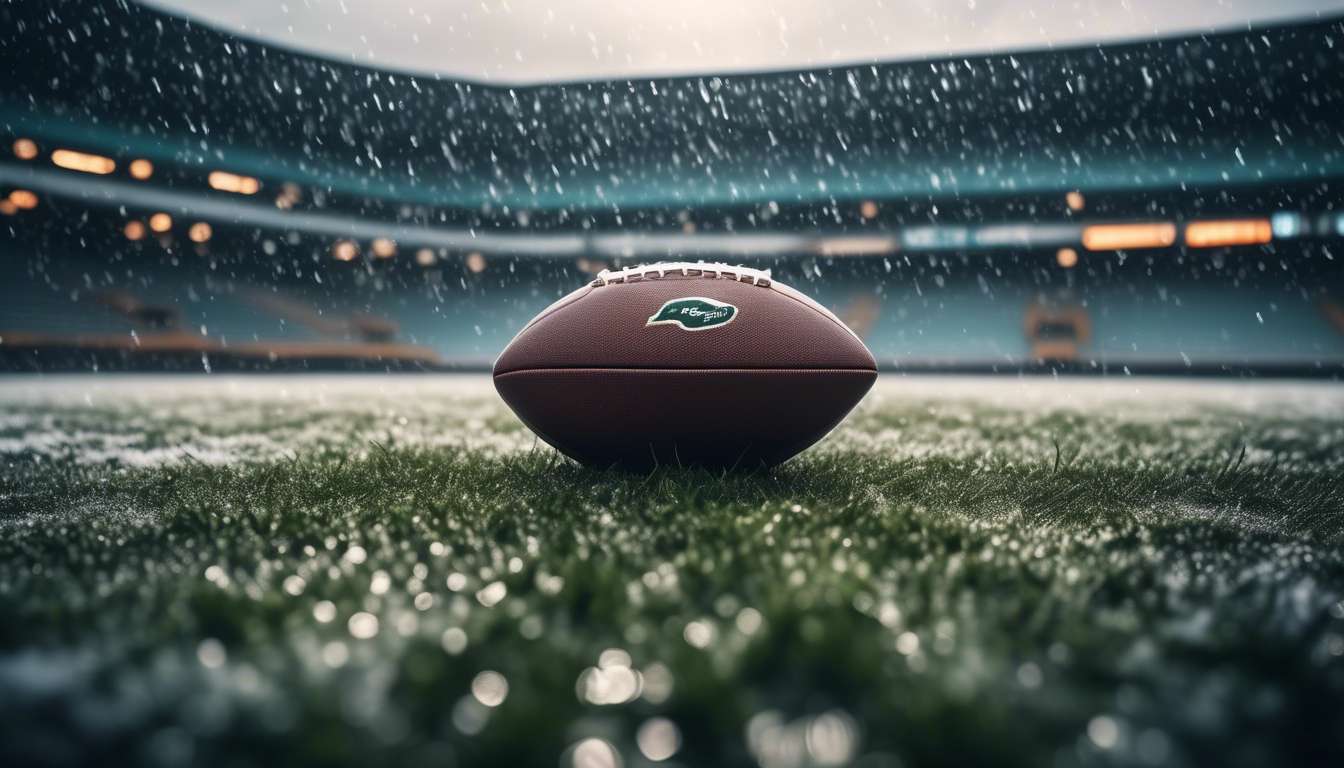As avid football enthusiasts, we have often marveled at how the weather can dramatically influence the outcome of a game. Whether we’re huddled together in the stands, braving the elements, or analyzing stats from the comfort of our homes, it’s evident that Mother Nature plays a silent yet powerful role in shaping the dynamics on the field.
From the sweltering heat that saps players’ energy to the slippery surfaces of rain-soaked pitches, each weather condition presents unique challenges and opportunities. Our shared experiences and observations have led us to delve deeper into this fascinating interplay between climate and competition.
In this article, we aim to explore how different weather conditions can:
- Alter team strategies
- Impact player performance
- Sway the results of much-anticipated matches
Together, let’s uncover the subtle yet significant ways in which weather patterns can tip the scales in the beautiful game of football.
Weather’s Influence on Team Strategies
Weather conditions significantly alter how teams plan and execute their game strategies.
As a collective, we know that a clear, sunny day offers a different set of opportunities compared to a rainy or snowy one. When we gather to support our team, we feel the impact weather has on game dynamics.
For instance, a slippery field changes how we handle the ball and adjust our offensive or defensive plays. Our coaches often remind us that adapting our strategies is crucial.
- In the rain, we might focus on short passes to maintain control.
- We may adjust our formations to counteract strong winds.
These strategic shifts aim to enhance player performance despite the challenges presented by the weather.
Together, we understand that weather conditions aren’t just background details—they’re integral to how we experience the game. By adapting to the elements, we not only support our team’s performance but also strengthen our bond within the community of fans and players alike.
Player Performance in Harsh Conditions
In harsh weather, we see players push their limits to maintain peak performance. The camaraderie on the field becomes palpable as we watch them tackle the challenges posed by extreme weather conditions. Whether it’s the blistering cold or scorching heat, these athletes dig deep, showcasing their resilience and determination. It’s in these moments that we feel a part of something bigger, witnessing the true grit and spirit of the game.
Weather conditions undeniably influence player performance and game dynamics. As teammates, we understand the importance of adapting quickly and supporting each other through every tackle and sprint.
- The wind may alter the ball’s trajectory, but it can’t sway our unity.
- We adjust our strategies, knowing that each player’s ability to perform impacts the outcome.
The bond formed under such pressure is unique. We’re not just watching a game; we’re sharing in a collective experience, rooting for those who embody the very essence of perseverance and teamwork in the face of adversity.
The Impact of Rain on Matches
Rain transforms the field into a slick, unpredictable landscape, testing our adaptability and strategy at every turn. We embrace the challenge as a team, knowing that unity and quick thinking enhance our collective resilience.
Weather conditions like rain demand that we adjust our tactics swiftly:
- Our passes need more precision.
- Footing becomes crucial as players navigate the slippery terrain.
- The rain doesn’t just affect the ball’s movement; it alters our entire approach to the game.
In these conditions, player performance is a testament to skill and flexibility. We rely on our training and trust in one another to maintain composure under pressure.
The rain can level the playing field, sometimes giving underdogs an unexpected edge, shifting game dynamics in surprising ways.
As fans, we share in the excitement and tension, knowing that each match in the rain is a unique test of teamwork and spirit. Together, we face the storm, united in our love for the game.
Snowy Surfaces and Game Dynamics
Snow transforms the field into a white expanse, challenging us to adapt our strategies and maintain our footing amidst the unpredictable conditions. Weather conditions like snow demand that we rely on teamwork more than ever. These games unite us, as the snow doesn’t just affect individual player performance but reshapes the entire team dynamic.
Trust in Teammates:
- We find ourselves needing to trust our teammates completely because:
- Visibility is limited.
- The ball’s behavior on such a surface is erratic.
Game Dynamics in Snowy Weather:
-
Modify strategies:
- Shorter passes replace long kicks to maintain control.
- The pace slows as we navigate the slippery terrain.
-
Test of resilience and adaptability:
- Surprising outcomes often occur as usual advantages are neutralized.
- Skill is blended with sheer determination.
Snow levels the playing field, making every match a unique battle. Our shared experiences in these conditions foster a deeper sense of camaraderie and belonging in the face of nature’s challenges.
Heatwaves and Player Endurance
When the sun blazes relentlessly during heatwaves, our endurance and hydration strategies are put to the ultimate test. Weather conditions like these challenge our physical limits and significantly impact player performance.
As a team, we know the importance of staying united and focused. We adapt to the intense heat by modifying our training and game approaches to maintain our energy levels.
In such conditions, player performance isn’t just about skill; it’s also about resilience and smart tactics. We rely on each other, ensuring that every member is well-hydrated and aware of the signs of heat exhaustion.
Our game dynamics shift as we:
- Opt for shorter passes
- Play slower to conserve energy
This creates a unique bond as we face the same challenges together.
We understand that these moments aren’t just about enduring the heat; they’re about embracing the shared struggle, reinforcing our sense of belonging, and persevering through adversity as a united team.
Windy Weather and Passing Accuracy
Strong winds can drastically alter our passing accuracy, forcing us to adjust our techniques and strategies on the field.
When the weather conditions favor high winds, we feel the pressure to adapt quickly. It becomes essential to modify our throws, often keeping the ball lower to cut through the gusts. As teammates, we lean on each other’s strengths, fostering a sense of unity as we navigate these challenges together.
Our player performance is truly put to the test under such circumstances. The wind can be an unpredictable opponent, shifting game dynamics in unexpected ways. We might see:
- Shorter passes gain prominence
- Long passes become riskier
Communication becomes key as we strive to maintain control and precision. Our camaraderie strengthens, knowing we’re all in this together, battling the elements as one unified team.
Ultimately, windy weather challenges us to be more than just skilled athletes; it prompts us to be adaptable strategists, enhancing our collective gameplay.
Fog’s Role in Game Visibility
Fog’s Impact on Visibility and Play
Fog can significantly reduce visibility on the field, challenging our ability to make precise plays and strategic decisions. When weather conditions bring in thick fog, it feels like we’re playing in a world wrapped in mystery. The ball disappears from sight, and so do our teammates and opponents.
Importance of Unity and Trust
In these moments, our sense of unity and trust becomes our greatest asset. We rely on each other more than ever to overcome the fog’s challenge.
Adaptation and Strategy Changes
Player performance often suffers as visibility drops:
- Quarterbacks struggle to spot receivers.
- Defenders have trouble tracking the ball.
We need to adapt quickly, altering our game dynamics to suit the conditions:
- Short passes and runs become crucial, as long throws risk being swallowed by the fog.
- Our communication on the field intensifies, with verbal cues gaining importance.
Instinctive and Connected Gameplay
Ultimately, fog forces us to play a more instinctive and connected game. It reminds us that football is not just about skill, but about teamwork and resilience.
Weather’s Role in Upsets and Victories
Weather’s Impact on Football
We know weather can turn the tide of a game, creating unexpected heroes and heartbreaking losses. When we’re gathered, united by our love for football, we witness how weather conditions challenge and redefine player performance and game dynamics.
Effects of Different Weather Conditions:
- Rain-soaked fields slow down speedsters but can level the playing field, allowing underdog teams to shine.
- Wind gusts can shift the trajectory of a football, altering passes and kick attempts, turning what seemed like a sure victory into an upset.
Weather as the Great Equalizer
We’ve seen this time and again when weather becomes the great equalizer, changing the dynamics from predictable to thrillingly uncertain. Players who handle adverse conditions with grit and adaptability often emerge as the game’s heroes, etching their names into our collective memory.
Community and Shared Experiences
As a community, we share these moments, knowing the unpredictable nature of weather can transform any match. Together, we celebrate those victories and learn from the losses, weathering every storm as one devoted fan base.
How do stadium designs help mitigate the effects of weather on football games?
Stadium designs play a crucial role in lessening the impact of weather on football games.
They often incorporate features such as:
- Retractable roofs
- Wind barriers
- Heating systems
By implementing these elements, stadiums can create a more controlled environment for players and fans.
Benefits of these features include:
- Ensuring that weather conditions have minimal influence on the game
- Allowing teams to focus on their performance without external factors affecting the outcome
Are there specific weather conditions that increase the likelihood of injuries during a football game?
Weather Conditions and Injury Risks in Football
Certain weather conditions can significantly heighten the risk of injuries during a football game. These conditions include:
- Rain
- Snow
- Extreme heat
Impact on the Game
- Rain and snow can make the field slippery, affecting players’ traction.
- Extreme heat can lead to players becoming less agile, increasing the chances of accidents.
Adaptation Strategies
To prioritize player safety and minimize the risk of injuries, it is crucial for teams to:
- Adapt their strategies according to the weather conditions.
- Use appropriate equipment designed for specific weather scenarios.
By taking these steps, teams can better ensure player safety while maintaining the integrity of the game.
How do fans’ experiences and attendance numbers change with varying weather conditions?
When weather shifts, our experiences at games transform too.
Rain can dampen attendance, but snow brings a festive vibe.
Sunny days draw bigger crowds, making the stadium buzz with excitement.
We adapt to the elements by:
- Bundling up in colder weather
- Seeking shade when it’s sunny
Our spirits can soar or dampen with the weather, but our love for the game remains constant.
Conclusion
In conclusion, weather plays a significant role in shaping the outcomes of football games. From influencing team strategies to impacting player performance, different weather conditions can lead to unexpected upsets or victories.
Whether it’s:
- Rain
- Snow
- Heatwaves
- Wind
- Fog
Each element adds a unique challenge that both teams must navigate.
Understanding and adapting to these weather factors can be the difference between success and defeat on the football field.




